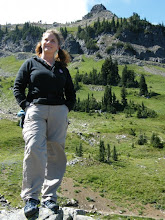Day 40:
Today was the 2nd session of the Marine Invert Taxonomy module looking at sea urchins, sea stars, tunicates (sea squirts), anemones and some lovely Tubularia hydroids. Have you ever really looked at a sea urchin in close-up detail??? Keeping the camera close to hand, I had a look at one of the live urchins under the microscope and WOW... what an amazing creature! Without a real 'brain', the urchin not only controls its spines and tube feet (just like sea stars), but also its pedicellariae (small jaw-like appendages on stalks used for attaching camouflage, cleaning and moving food around the outside of its body to its mouth). If you look closely you can see them in the photo. They almost look like carnivorous tulips mixed in and amongst the purple-tipped spines. Tube feet (the red-ringed disc-like structures) cover their entire body and not only are used for movement, but also form the basis of the echinoderm (spiny skin) hydrostatic (water pressure) skeleton. Healthy urchins can 'right' themselves when turned upside down in 60-90 seconds, which is pretty damn quick given the amount of coordination necessary in a brainless critter!





No comments:
Post a Comment